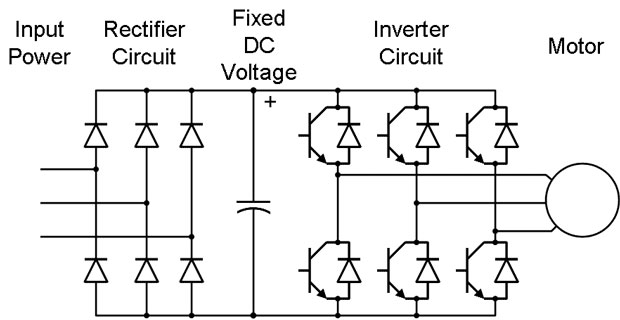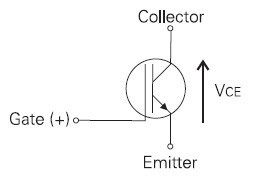Cautions before installing, wiring and operating a VFD
Read all operating instructions before installing, wiring, operating, servicing or inspecting the VFD. Ensure that the instruction manual is made available to the final user of the VFDs as well as all personnel involved in any aspect of installation, adjustment or maintenance. Your VFDs must be applied and installed by a suitably qualified and experienced electrical trades person in accordance with this manual, good engineering practice and all local rules and regulations.
There are hazardous voltages inside the VFD whenever it is connected to an electrical supply and for some time afterwards. Before touching anything inside the VFD enclosure or other equipment connected to the VFD terminals, disconnect all sources of electrical power, wait at least 11 minutes for capacitors within the VFD to discharge to less than 50VDC and then ensure, by measurement, that there is no hazardous AC or DC voltage present at any terminal.
 The VFD contains high energy circuits that may be hazardous. Do not operate the VFD with the door open or any part of the enclosure removed. Do not touch the terminals of the VFD or any associated motor and wiring when it is energised, even if the VFD and motor are stopped. Electric shock may result. Do not modify this equipment electrically, mechanically or otherwise. Modification may create safety hazards.
The VFD contains high energy circuits that may be hazardous. Do not operate the VFD with the door open or any part of the enclosure removed. Do not touch the terminals of the VFD or any associated motor and wiring when it is energised, even if the VFD and motor are stopped. Electric shock may result. Do not modify this equipment electrically, mechanically or otherwise. Modification may create safety hazards.
The VFD is designed to drive an appropriately rated and otherwise suitable 3 phase induction motor. It is not suitable for single phase motors or other types of motor or non-motor load. Use with inappropriate load types may create a safety hazard.
Where the VFD is used as a component part of another product, it is the purchaser's responsibility to ensure that the final product meets all of the necessary safety, EMC, regulatory, operational and other requirements for that product. Requirements for the purchaser's final product may be substantially different to the requirements for stand-alone inverters.
The VFD is intended for use only in fixed wiring applications. Mount the VFD on a vertical, incombustible surface such as metal or masonry. Do not place combustible or flammable material near the VFD. Failure to observe these precautions may create a fire hazard. The VFD is manufactured under strict quality control arrangements, however additional and independent safety equipment must be installed if the application is such that failure of the product may result in personal injury or property damage.
Ensure that electrical noise generated by the product and any associated equipment does not adversely affect the proper operation of other equipment or systems, particularly those that have a safety function. Install emergency stop circuitry that removes power from the VFD and does not depend on any feature of the product for proper and safe operation. Do not use the braking functions of the product for safety purposes.
The VFD has features that may be used to cause an automatic restart in certain circumstances. The overall application (machine etc) must be designed such that automatic restart is not hazardous. Do not install the VFD in locations where mechanical damage to the enclosure is possible. In particular, consider vehicles, vandalism and attack by insects or animals. Severe equipment damage and safety hazards may result.
There are hazardous voltages inside the VFD whenever it is connected to an electrical supply and for some time afterwards. Before touching anything inside the VFD enclosure or other equipment connected to the VFD terminals, disconnect all sources of electrical power, wait at least 11 minutes for capacitors within the VFD to discharge to less than 50VDC and then ensure, by measurement, that there is no hazardous AC or DC voltage present at any terminal.
 The VFD contains high energy circuits that may be hazardous. Do not operate the VFD with the door open or any part of the enclosure removed. Do not touch the terminals of the VFD or any associated motor and wiring when it is energised, even if the VFD and motor are stopped. Electric shock may result. Do not modify this equipment electrically, mechanically or otherwise. Modification may create safety hazards.
The VFD contains high energy circuits that may be hazardous. Do not operate the VFD with the door open or any part of the enclosure removed. Do not touch the terminals of the VFD or any associated motor and wiring when it is energised, even if the VFD and motor are stopped. Electric shock may result. Do not modify this equipment electrically, mechanically or otherwise. Modification may create safety hazards.The VFD is designed to drive an appropriately rated and otherwise suitable 3 phase induction motor. It is not suitable for single phase motors or other types of motor or non-motor load. Use with inappropriate load types may create a safety hazard.
Where the VFD is used as a component part of another product, it is the purchaser's responsibility to ensure that the final product meets all of the necessary safety, EMC, regulatory, operational and other requirements for that product. Requirements for the purchaser's final product may be substantially different to the requirements for stand-alone inverters.
The VFD is intended for use only in fixed wiring applications. Mount the VFD on a vertical, incombustible surface such as metal or masonry. Do not place combustible or flammable material near the VFD. Failure to observe these precautions may create a fire hazard. The VFD is manufactured under strict quality control arrangements, however additional and independent safety equipment must be installed if the application is such that failure of the product may result in personal injury or property damage.
Ensure that electrical noise generated by the product and any associated equipment does not adversely affect the proper operation of other equipment or systems, particularly those that have a safety function. Install emergency stop circuitry that removes power from the VFD and does not depend on any feature of the product for proper and safe operation. Do not use the braking functions of the product for safety purposes.
The VFD has features that may be used to cause an automatic restart in certain circumstances. The overall application (machine etc) must be designed such that automatic restart is not hazardous. Do not install the VFD in locations where mechanical damage to the enclosure is possible. In particular, consider vehicles, vandalism and attack by insects or animals. Severe equipment damage and safety hazards may result.
Post a Comment:
You may also like:
Featured Articles
What is VFD, How it works? - VFD ...
 VFD is shorted for Variable Frequency Drive (also known as AC Drives and Inverters) -- that's used to make an AC motor working in ...
VFD is shorted for Variable Frequency Drive (also known as AC Drives and Inverters) -- that's used to make an AC motor working in ...
 VFD is shorted for Variable Frequency Drive (also known as AC Drives and Inverters) -- that's used to make an AC motor working in ...
VFD is shorted for Variable Frequency Drive (also known as AC Drives and Inverters) -- that's used to make an AC motor working in ...VFD: Insulated Gate Bipolar Transistor ...
 IGBT (insulated gate bipolar transistor) provides a high switching speed necessary for PWM VFD operation. IGBTs are capable of ...
IGBT (insulated gate bipolar transistor) provides a high switching speed necessary for PWM VFD operation. IGBTs are capable of ...
 IGBT (insulated gate bipolar transistor) provides a high switching speed necessary for PWM VFD operation. IGBTs are capable of ...
IGBT (insulated gate bipolar transistor) provides a high switching speed necessary for PWM VFD operation. IGBTs are capable of ...Three phase inverters
 In the variable frequency drive rectifier paper, it explains how to go from three phase alternating current voltage to a direct ...
In the variable frequency drive rectifier paper, it explains how to go from three phase alternating current voltage to a direct ...
 In the variable frequency drive rectifier paper, it explains how to go from three phase alternating current voltage to a direct ...
In the variable frequency drive rectifier paper, it explains how to go from three phase alternating current voltage to a direct ...Variable Frequency Drive Harmonics and ...
A discussion of the benefits of variable frequency drives often leads to a question regarding electrical harmonic distortion ...
Variable frequency drive Rectifier
 To understand variable frequency drive (VFD) better, it's necessary to explain some of the main parts of the variable frequency ...
To understand variable frequency drive (VFD) better, it's necessary to explain some of the main parts of the variable frequency ...
 To understand variable frequency drive (VFD) better, it's necessary to explain some of the main parts of the variable frequency ...
To understand variable frequency drive (VFD) better, it's necessary to explain some of the main parts of the variable frequency ...
VFD manufacturers
